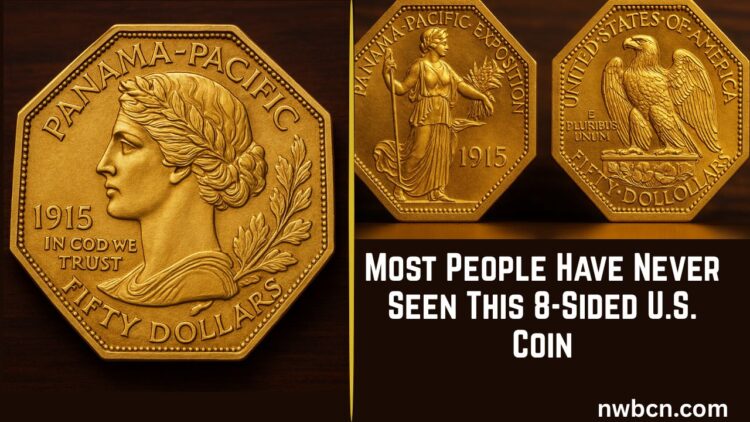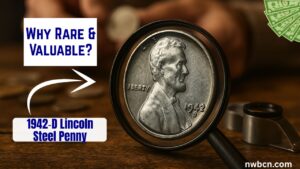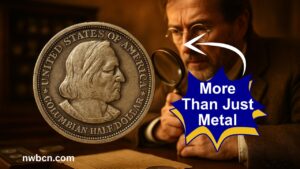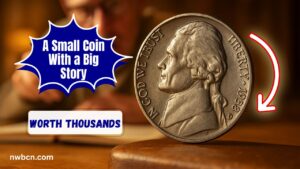The 1915 Panama-Pacific Octagonal Gold Coin is one of the most celebrated and distinctive coins in the history of U.S. coinage. It was issued during the Panama-Pacific International Exposition held in San Francisco.
What makes this coin apart from nearly every other U.S. coin is its eight-sided shape, a rare departure from the traditional circular form. Struck in .900 fine gold, the coin weighs over 2.5 ounces (83.57 grams) and measures nearly 44 millimeters in diameter, making it one of the largest and heaviest coins ever issued by the United States Mint.
Only 645 pieces were officially distributed to the public—the 1915 octagonal $50 gold coin has become a numismatic legend, highly coveted by collectors for its rarity, historical significance, and striking design. Over a century later, it remains a treasured artifact not only of American coinage but of a defining moment in U.S. and global history.
Background Of The Discovery
Robert Aitken designed these 1915 Panama-Pacific gold coins. These octagonal coins feature symbolic and classical representations that reflects both the grandeur of the exposition and the aspirations of a nation emerging as a global power.
The obverse displays the helmeted head of Athena, the Greek goddess of wisdom and war. At the same time, the reverse features a powerful owl perched on a pine branch, symbolizing watchfulness and knowledge. A ring of dolphins encircles the coin’s border, representing continuity and unity of the two oceans joined by the canal.
The $50 Panama-Pacific gold coins are massive, heavy coins made of a relatively soft metal. As a result, the coins are susceptible to wear and damage, making it difficult to find exceptional examples. The majority of survivors are Mint State, usually in MS63. Gems are scarce, and the best examples top out at MS66.
1915 Panama-Pacific Set with Original Mint Letters
There are a total of five sets of these rarely available coins ,which are as follows:
- a $50 Gold Octagonal Coin graded NGC MS 65
- a $50 Gold Round Coin graded NGC MS 64
- a Quarter Eagle graded NGC MS 66
- a Gold Dollar graded NGC MS 65
- a Silver Half Dollar graded NGC MS 64
The $50 gold coins are particularly noteworthy. The $50 Gold Octagonal Coin is the only US coin of its kind. Its grade of NGC MS 65 is surpassed by a mere 13 examples in the NGC Census, as of early February 2025.
Its companion, the $50 Gold Round Coin, shares the same artistic excellence in depicting the Roman goddess Minerva on the obverse and an owl perched on Ponderosa pines on the reverse.
How These Coins Have Been Sold Over Time
1. Initial Sale (1915 Exposition)
At the exposition, the coins were:
- Priced at $100 each (double face value) to cover production and promote prestige.
- Sold in limited quantities—many buyers were turned off by the high price.
- Packaged in custom leather cases, some of which are now collectibles themselves.
2. Secondary Market Growth (1920s–2000s)
Over the past few decades, the pieces that have survived have gotten into the hands of elite collectors and numismatists. The trends include:
- Rising values through the 20th century as collectors recognized the coin’s uniqueness.
- Interest rates were increased between the 1980s and 1990s when graded coin collecting became more popular.
3. Modern Auction Sales and Record Prices
Stack’s Bowers, Heritage Auctions, and Sotheby’s these auction houses have regularly featured these coins for the purpose of finding a compatible collector. The price of sale can be different according to the condition, original packaging, and grading.
Today, graded MS-63 and higher octagonal coins consistently fetch $120,000–$250,000 or more, depending on the market.
| Date | Grade | Certification | Sale Price (USD) | Notes |
|---|---|---|---|---|
| Jul 2005 | MS‑67 | NGC | $289,671 | Auction record for any octagonal $50 coin |
| Apr 2022 | MS‑66 | NGC (Stack’s Bowers) | $180,000 | Premium example in high grade |
| Jun 2022 | MS‑64+ | PCGS | Approx. $163,125 | CAC‑approved (Simpson Collection) |
| Aug 2023 | MS‑64 (CAC) | PCGS | ~$84,000 | CAC designation, solid mid-grade |
| Nov 2023 | MS‑63 | PCGS | ~$84,000 | Typical mid-range grade |
| Mar 2025 | AU‑58 | PCGS – AU grade | $57,600 | Mint-state quality, albeit uncirculated |
| Jan 2025 | MS‑64 (CAC) | NGC (Heritage func. auction) | $82,500 | CAC-approved, strong surfaces |
| Feb 2021 | MS‑64+ | PCGS | $163,125 | High-grade certified sale |
| Sep 2024 | MS‑63 | PCGS | (Unspecified recent sale, consistent with mid‑$80K range) |
This 1915 Panama-Pacific Octagonal Gold Coin is more than just a piece of gold; it represents the iconic innovations of the human mind. With less than 650 coins, which are known as surviving coins and a design that can not be easily copied or made into U.S. coinage, its value continues to skyrocket over time. But rarity alone is not enough; preservation is necessary for maintaining and increasing its worth.
Storing the coins at bank storage, certified grading, humidity control, and hands-off handling not only helps protect your investment but also ensures its legacy for future collectors and sale auctions.
Whether you inherited one from the family or place, purchased it at auction, or are safeguarding it for resale, following expert preservation practices is necessary for keeping your coin safe, rare, and worthy of a six-figure value.
FAQs
Q1: Do we have to clean the 1915 Panama-Pacific Octagonal Gold Coin to make it shine more?
No. Cleaning can significantly damage the coin’s surface and reduce its value. Collectors and grading agencies prefer coins in their original, unaltered condition—even if they appear dull or toned.
Q2: Where is the safest place to store this rare coin?
For maximum protection, store the coin in a fireproof, humidity-controlled safe at home. It must remain in a certified holder or protective capsule that is away from light, heat, and moisture.
Q3: Does the original box or case increase the coin’s value?
Yes. Original packaging, especially the 1915 leather or velvet-lined case, can add thousands of dollars to the coin’s value due to its historical authenticity and appeal to collectors.




